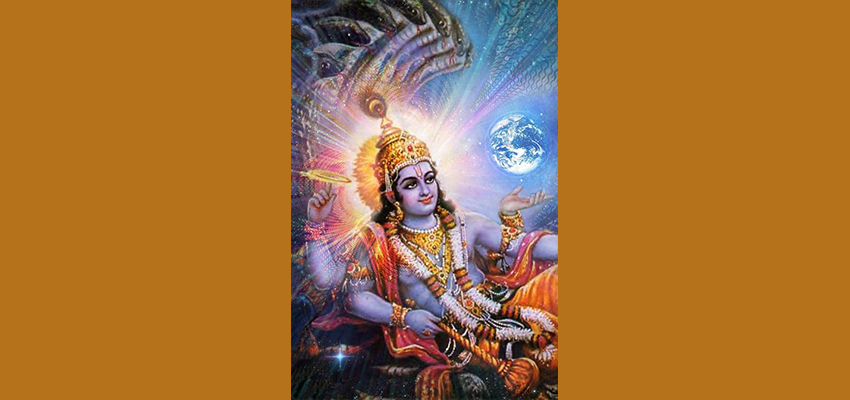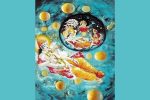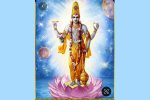NAME 9
Bhūtabhāvanah भूतभावनः
He nourishes His creations. Brahman not only creates, but also nourishes. Whatever is created has to be nourished. This nāma elucidates His compassion. Brahman is full of compassion. Brahman creates with an intention to liberate the souls. But, men are deluded by ignorance fails to realise the purpose for which they are created. In spite of this, He nourishes them as per nāma 6.
९. ॐ भूतभावनाय नमः
9. Om Bhūtā-bhaavanaay Namah
9.Bhoota-bhaavanah -One who creates and multiplies the creatures; meaning the One, who is the cause for the birth and who is responsible for the growth of all living creatures. One who nourishes and nurtures all beings that He created. Who fascinates the minds of all beings.
INTERPRETATION GUIDED BY SANT VANI (WORDS OF SAINTS)
BHUTABHĀVANAḤ:
The creator and sustainer of all things.
Some people can create things but cannot take care of them. Others can take care of things, but cannot create them. Some people can initiate a project but cannot run it. Others can run it, but cannot initiate projects. There are other people, who cannot wind up projects; they cannot give it up. A mother may give birth to a child, but may not be able to take care of it; she needs a baby-sitter.
But, Bhagavānbhūtānibhāvayati, janayati–creates all beings, and again, bhūtānibhāvayati, vardhayati–looks after them, by providing all the nourishment for the variety of living beings. He is bhūtakrt, bhūtabhrt, bhūtabhāvana and bhūtakrt–He initiates the creation, takes care of it and also withdraws it, at the right time.
The Lord visualizes the entire world before creating it. He is the only creator and the only architect. There is no other architect for this creation. If Bhagavān is the karta, the doer, then, who is the kaarayita – the one who make a person do? Who is the one who makes Bhagavān work? If there were a kaarayita, then that person would become Bhagavān! So Bhagavān is both the karta and the karayita. Brahmāji is considered to be the creator, but the Lord is the maker of the creator, and He is also the one who makes the creator do his work. It is like the supervisor who is being supervised!
With one glowing fire-brand or phuljari (what we light during Diwali) many patterns can be drawn by whirling it around. This can be called creation of patterns. When the whirling is stopped, there is only one glowing tip and this is samhara or withdrawal(of patterns). Is this destruction? No.
At the time of danger, a turtle withdraws its legs, neck and tail into the shell. When everything is safe, it comes out.
There is no destruction in this withdrawal. Here too, it is the dance of Parameśvara. When He dances, the whole creation is set in motion. When the dance stops, the creation ends. It is only withdrawn, not destroyed because it will manifest again.
BHUTABHĀVANAḤ: is the ninth name and completes the second line of the first couplet:
भूतकृद्भूतभृद्भावो भूतात्मा भूतभावनः ।
“He who is the initiator of the creative process of the Universe and also the destroyer ” (BHŪTAKṚD:) and “He who is the sustainer, supporter, and real source of deep-strength as the indwelling ‘governor’ of our lives” (BHŪTABHṚT:) is also the supreme and pure indwelling essence that every one seeks as his/her goal in life (BHĀVAḤ:), He lives within each being, as the Ātmā that अंतर्यामी (Antaryāmi), dwelling deep within the cave of the heart and is established there as the ‘living-principle’ and is an Aṁșā of the divine – (BHUTĀTMĀ:)
The last name in this specific string which uses the prefix BHUTĀ for each name, ends with BHUTABHĀVANAḤ.
There are two commentaries on the Vishnu Sahasranama that are considered authoritative – the first and more popular one is the one by Śaṅkara which takes the Ādvaita (अद्वैत) viewpoint and the second that takes the Viśiṣṭādvaita (विशिष्टाद्वैत) viewpoint by Parasara Bhattar. In the former, the emphasis is on the निर्गुण (Nirguna) and in the latter the सगुण (Saguna) swarupa of the Brahman/Paramatman.
To Śaṅkara’s credit it must be mentioned that although he held the Nirguna-Brahman to be the ultimate reality, he composed some of the most beautiful and evocative stotras describing the beauty and grandeur of the divine forms of various deities.
Although there is significant overlap between the two commentaries in terms of the meanings of each name, there are also deviations in some instances. The first such instance was with the name “VAṢATKARĀḤA:” where one may chose to go with Śaṅkara. In the case of BHUTABHĀVANAḤ: one may prefer Parasara Bhattar. In addition, the ideal method is also to read the name, the associated commentary, reflect upon the meaning and then interpret it based on the answers one gets (as a consequence of that reflection).
It is also a fact that for most of us it is through the contemplation of the Saguna that it is possible to gradually proceed towards the Nirguna-Nirākarā (attributeless-formless) unless one is a Sadasiva Brahmendra or a Ramana.
He, who by virtue of being the creator (initiator of the creative process), Sustainer, Protector, and Director, bestows on all beings (Bhutās), things that sustain them, nourish them, and help them grow (materially as well as spiritually). This he can do on account of him being “Seshi” (The supreme master of the Universe and who’s suzerainty reigns over the entire Universe.). Note that “Seshi” is different from “Sesha” which denotes a ‘subordinate’ relationship and hence Ādi Śeṣa serves as the bed on which Maha Vishnu reclines (see also the relationship of Lakshmana to Rama).
Nothing teaches and nourishes one like life itself.



